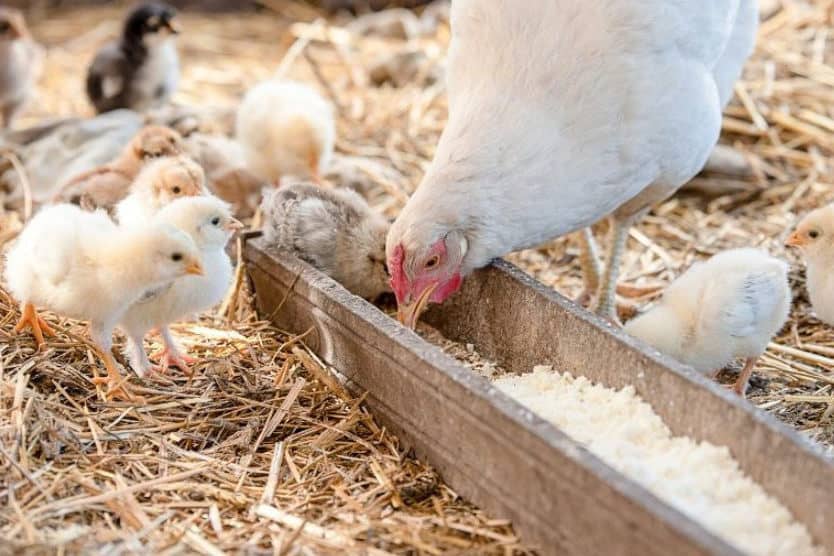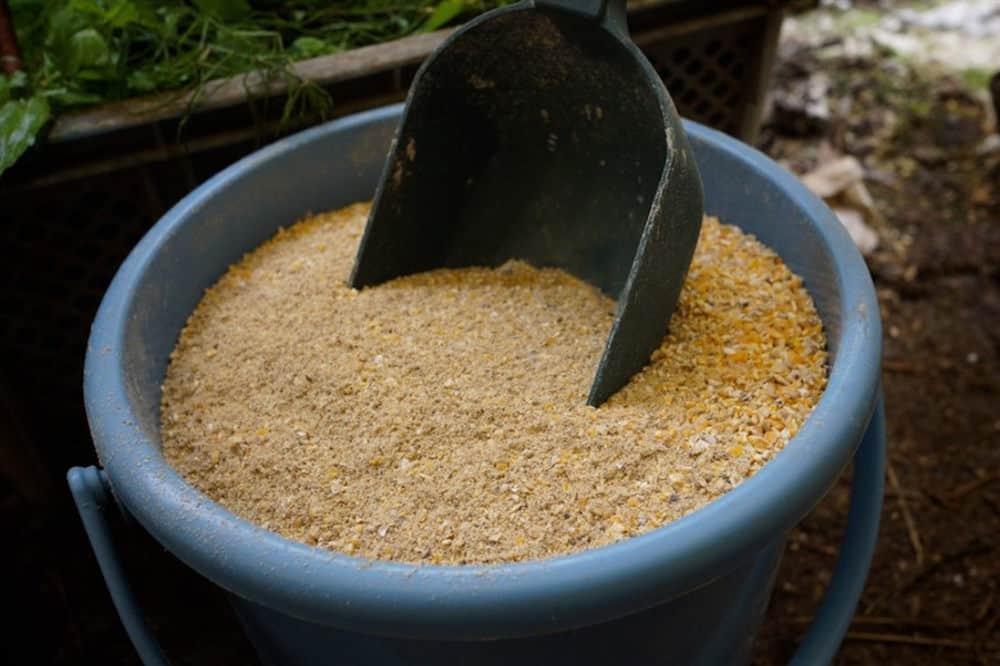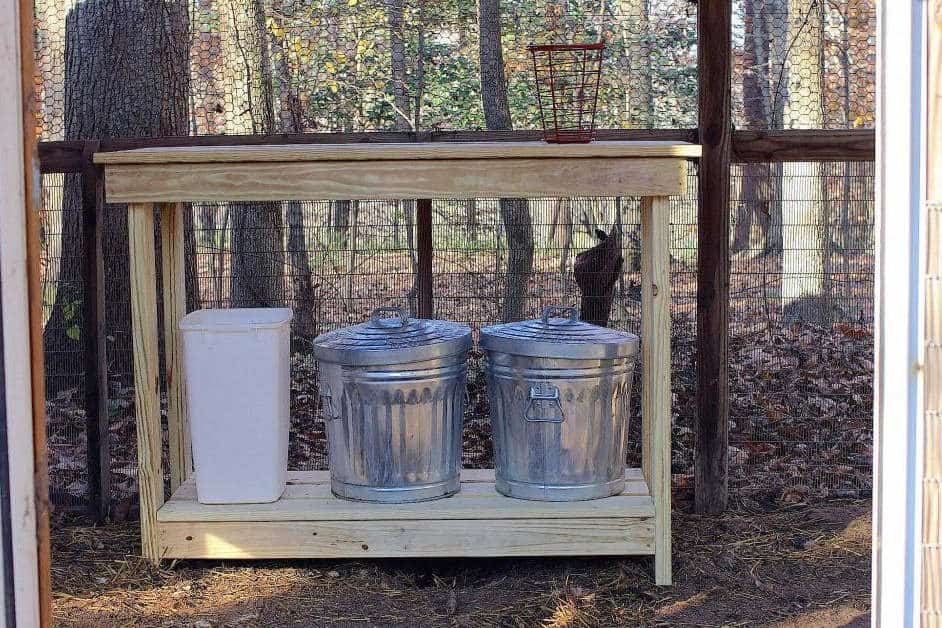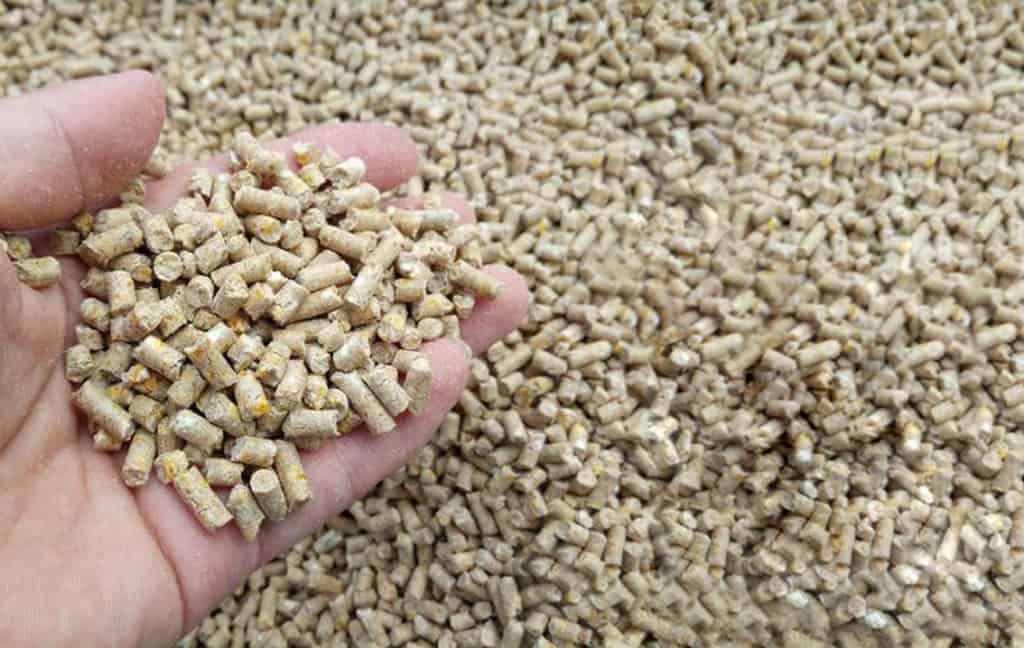Every poultry farmer anticipates keeping a healthy flock of chickens that are happy and well-fed. But how can you achieve this? It’s easy; start by storing your chicken feed correctly. That is why this article guides you on how to store chicken feed to ensure healthy and productive chickens if you are new to poultry keeping.

What are the types of chicken feed?
For you to understand how to store chicken feeds, it is important to know the types of chicken feeds and what nutrients are contained in these feeds. Are you buying the correct feed for your chickens? Are you also balancing the feed diet properly for your chickens?
The feed type you will buy for your chickens depends on their age and purpose. Are they chicks, growers, layers, broilers, or roosters? do you also keep ducks among your flocks?

Overall, there are four types of chicken feed;
- Whole grain
- Mash
- Pellets
- Crumble
These four types of chicken feed have basically similar ingredients but with different characteristics and processing levels. For example, mash, pellets, and crumble are made out of whole grains.
Whole grain feed, as the name suggests, are cracked grains that also contain other natural ingredients nutritious to your chicken. Chickens love whole grain feeds as it is not only food for them but your chickens also enjoy pecking on the hard grains; it is a natural instinct for them.
Mash chicken feed is ground whole grain feed but in its natural form. You will feed these to your chicks. Usually, they are in powder form which makes it easier for your chicks to feed. The only disadvantage with mashed chicken feed is that they are easily wasted as they spill a lot due to its pounded nature. No wonder you need to store the feeds safely and only serve your chicks the right quantity.
The video below shows the types of chicken feed and at what stage to administer the feeds
Pellets chicken feed is a mixture of whole grain feeds and other chicken-friendly ingredients. They are then processed further and molded into small compact pellets. If you buy feeds for your chicken, you will notice that this is the most common one that farmers love. Poultry farmers love pellets because they are easy to manage, have a longer shelf life and you can control wastefulness.
Crumble chicken feed has particles slightly smaller than pellets but bigger than mash and processed.
The most common type of chicken feed that most poultry farmers purchase is chick mash, pellets, and crumbles. To help your chicken get an all-around diet, remember to include chicken supplements, treats, and water.
Tips to store chicken feed the correct way
So, you have identified and purchased the right chicken feed for your flock. How do you store the feed to ensure your chickens get the most out of it?
Here are the top tricks to guide you.
Keep the feeds elevated

Whatever place you decide to store your chicken feed, ensure it is elevated. But again, you want to look at how many meters off the ground you’re doing this. For example, if you elevate your chicken feed only 30cm off the ground surface, it may not do much good. Rodents such as mice and squirrels will find a breeding ground underneath and sneak their way into your feeds.
The best way to elevate chicken feed storage is to raise it high enough that you can clearly see underneath. The moment the underneath is dark and hidden, you risk your chicken feed being invaded by rodents.
How about concrete floors?
Even if your chicken feeds are safely stored in a bag, do not place that bag on a bare floor, especially a concrete floor. Concrete floors will let moisture seep into your feeds and dampen them. Do you want to feed your chickens on damp feeds? Of course Not.
Apart from your feeds getting damp, they will also inhibit microorganisms that are harmful to your chickens. And you may find lumps of feeds within the bag.
How should you store your chicken feeds?

You can store your chicken feeds in two ways.
- In their original bags
- In containers
A good practice is to keep your chicken feeds in their original bags.
So, let’s quickly brainstorm why it is okay to leave your chicken feeds in the bags they came with.
Reduces confusion
First, it minimizes confusion because the bag is already labeled by the manufacturer. It has the type of feed whether it’s mash, pellets, grains, or crumbles. It also has information on which chickens to feed; do you feed chicks, growers, layers, roosters, or broilers? So, the labels will make your work easier in the long run.
Could lead to a chemical reaction
If you pour your chicken feed directly into a container, it may lead to a reaction between the feed and the walls of the container. The reaction could contaminate your chicken feeds yet you want your chickens to have a healthy feed free from impurities.
But if you prefer to pour your chicken feed directly into a container, at least ensure your container is galvanized with chicken-feed-friendly material or paint. You will read about storage containers later in this article.

Easy rotation
It is so easy to rotate your feeds when they are in their original bags. For instance, let’s say you always keep your feeds in their original bags. If you buy a new bag of feeds, you will simply pull out the current bag your chickens are feeding on, and place the new one below and the current one on top. There you have it. Rotation done! This way, chances of mixing up feeds and feeds going bad are close to minimal.
Remember this tip
Note that if you keep your chicken feeds in their original bag, you want to apply extra caution and place them in another container for further safety. Otherwise, rodents will tear into the bag and eat or infect the fresh feeds.
This video shows you how to store chicken feed the correct way
Choose the correct container type
Now, the fun part. Let’s talk about storage containers. You may want to store your chicken feed by directly pouring them into containers. Which is the right container? Must you cover the containers if your chicken feeds are in their bags?
Metallic containers are the best as rodents cannot penetrate and spoil your feeds. Just remember to keep the feeds with the entire bag or use food-safe containers.
Thick plastic airtight containers are great but can only serve for some time. Before you know it, rodents have eaten up the walls and reached your flock’s food.
Remember to use dark translucent containers. If you opt for transparent drums, they will attract light which degrades your chickens’ feed’s minerals.
Ensure your chicken feed is dry
You want to ensure that you keep your chicken feeds dry. Chickens love dry feeds. If they get wet, they will start to form molds which are fungus that attracts microorganisms. Such feed becomes poisonous to your flock. Such mistakes will make chickens reject their feeds. Besides, the chickens will turn down wet feeds. You don’t want your chickens to go on a hunger strike, do you?
Moreover, keep your chicken feed safe from rainwater coming from up and also from surfaces that could seep into your bags or container of feed.
Keep your chicken feeds cool
Ensure to keep your chicken feed cool. When you keep the feeds in warmth, they will attract moisture which leads to molding. Molding makes feeds clump together and inhibit microorganisms. Your chicken will not get sufficient nutrients from moisture-filled feeds.
What is the ideal place to keep your chicken feeds cool?

If you want to keep your chicken feed cool, keep them inside or under the shed. If you leave them out in the sun, they will warm up and condense when temperatures drop.
What if you don’t have enough space inside? You can still keep the feeds outside, and make a shelter or a shed for your containers. Alternatively, insulated containers can also work in case your chicken feeds are in direct sunlight.
Check out this video on how to store chicken feed
Tidy up the storage area and keep it properly lit
Do not overlook this storage tip especially if you are wanting to keep away rodents such as mice. A storage area that is neat will discourage rodents from crawling about. You see, rodents love areas that are hidden and busy as their presence often goes unnoticed.
Can you see everything in your storage area or is there a section that is hidden? That may be a perfect hiding spot for rodents. Besides, it is easier to inspect the quality of feeds if they are in a well-lit place.
Also, regularly tidying up your chicken feed storage space will prevent any possible contamination. That is why you shouldn’t leave your storage bags open.
Store your feeds according to their shelf life
Check the expiry date of the feed before buying and store them according to the expiry date for easier rotation. To keep your feed from going bad, buy the quantity your chickens require and can finish before the expiry date, and avoid mixing feeds with different expiry dates. The golden rule is; first in first out.
But how long can you keep chicken feed fresh?
To be on the safe side, buy feeds that your chicken can eat and finish within a short period. Do not overstock for convenience. Chicken feed can stay fresh for up to 4 months. Although pellets will last up to 6 months.
Summary
Your chickens will now get the best out of their feeds, especially if you apply these simple tips on how to store chicken feed. Store your feeds elevated, cool and dry. Ensure your storage area is shaded, tidy, and well-lit. Additionally, rotate your feeds according to the expiry date. Happy poultry keeping!


Joseph Hudson has been raising chickens for over 15 years. In 2018, he completed the Agriculture & Natural Resources program at Mt. San Antonio College. He currently raises over 1400 chickens on his 7.5-hectare farm. He keeps sharing his experience on raising healthy and happy chickens on Chicken Scratch The Foundry.







